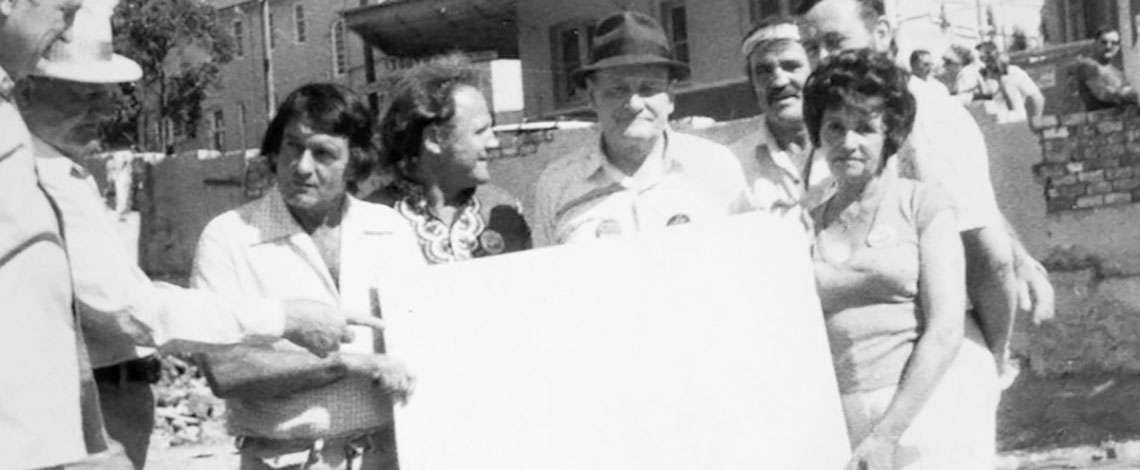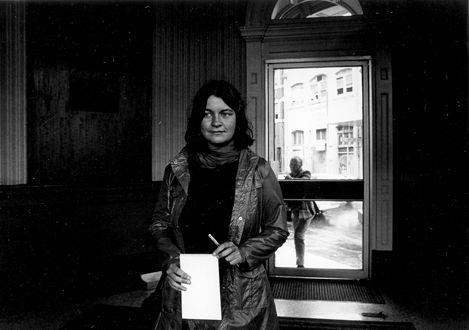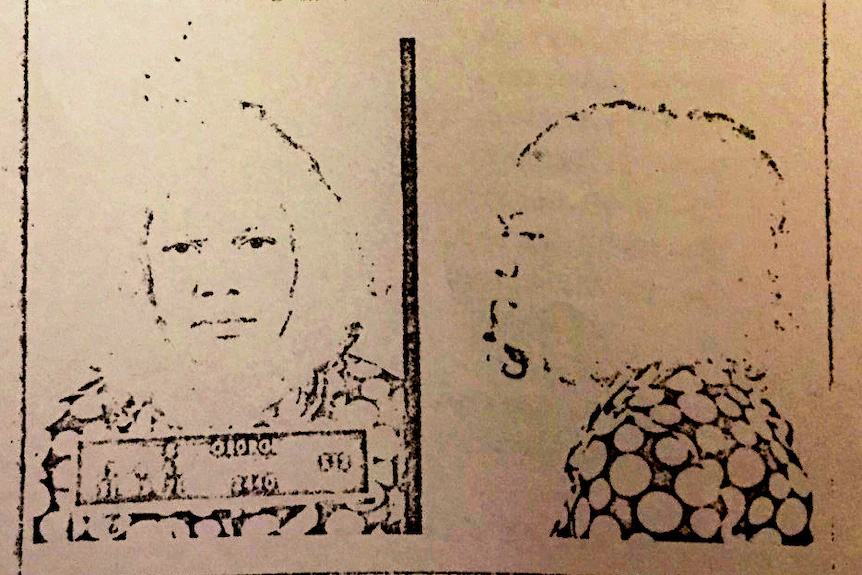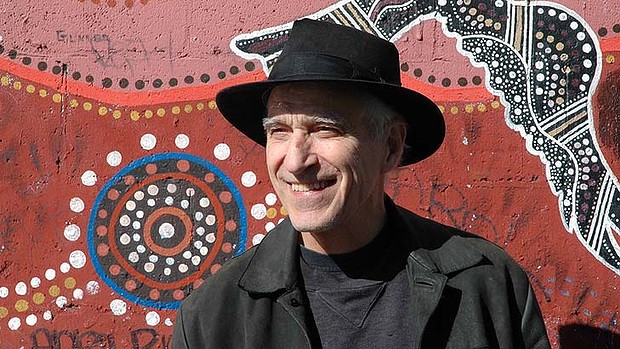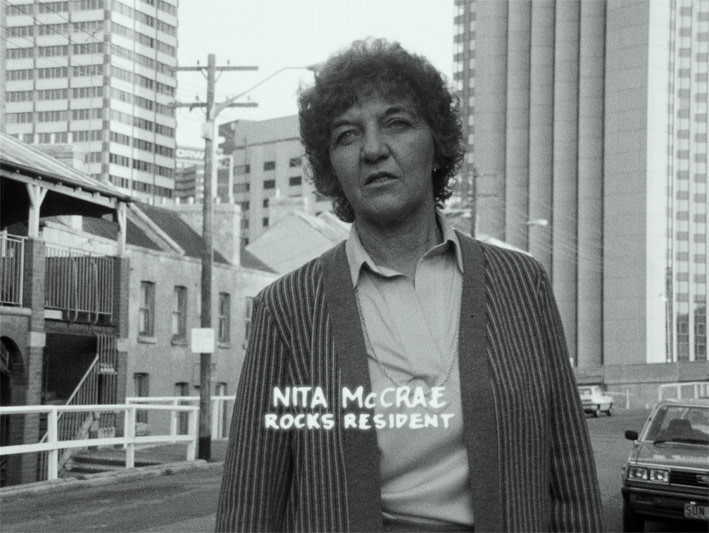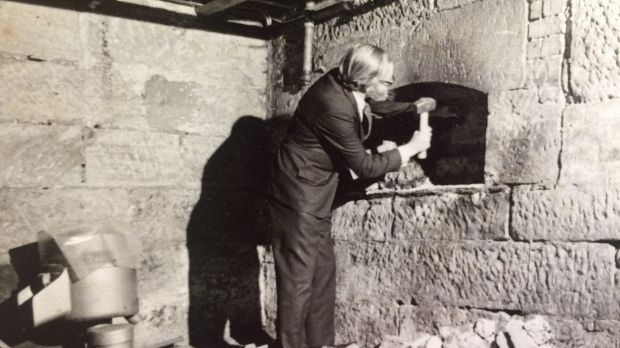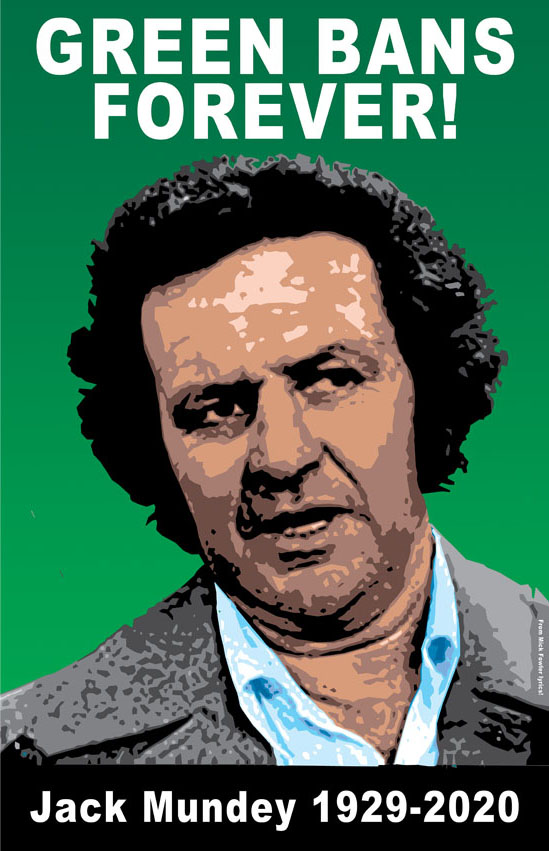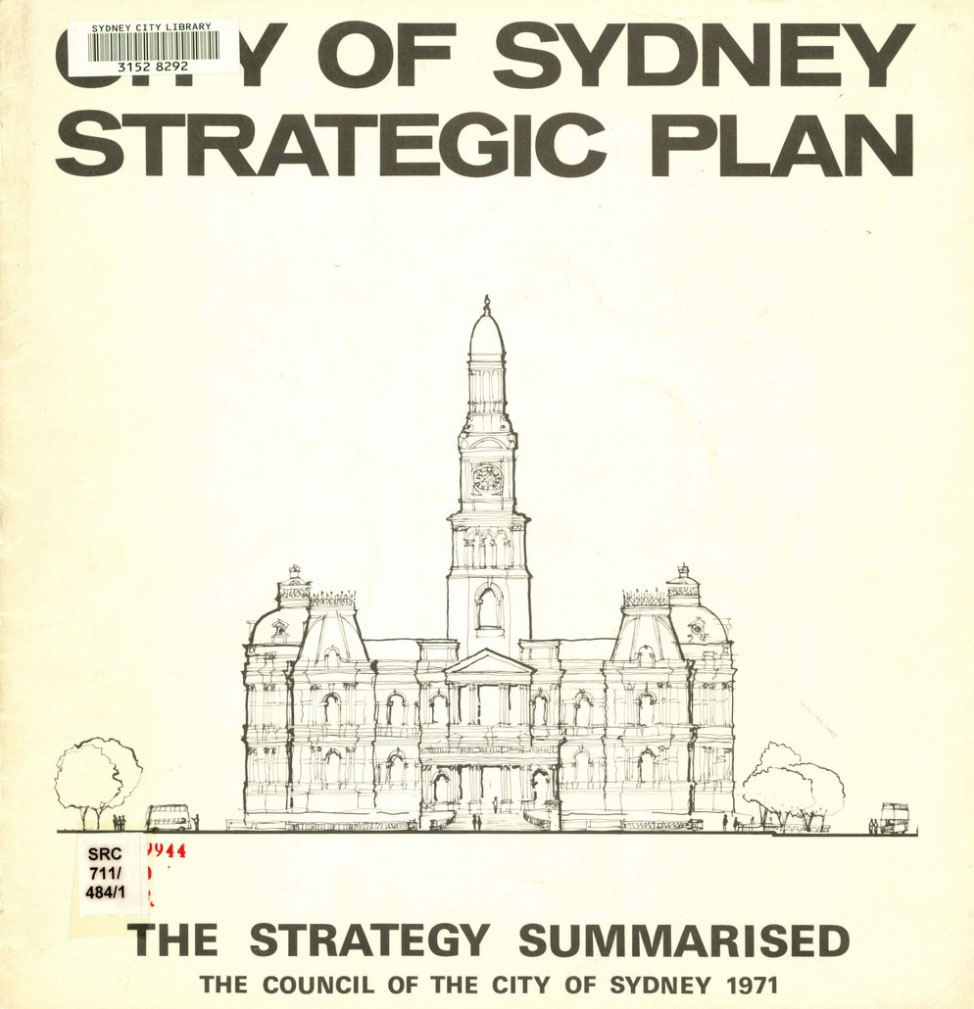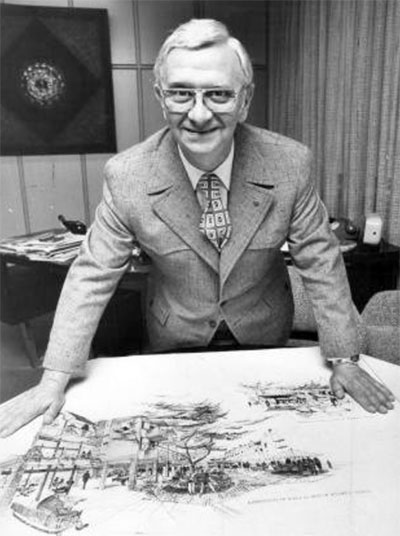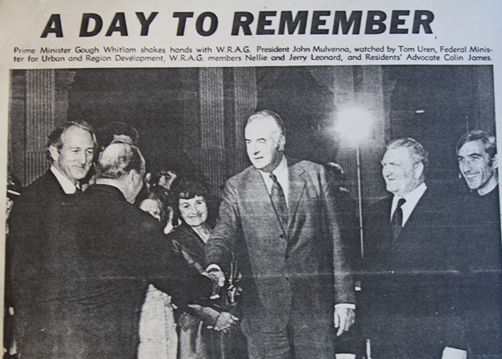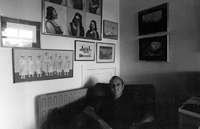Green Bans People and Players
Aboriginal sites
The BLs supported Green Bans in Redfern and Waterloo. Increasingly sites of Aboriginal and Torres Strait Islander heritage are being recognised and protected, such as the Budj Bim Cultural Landscape in Victoria, which was placed on UNESCO’s World Heritage List in 2019.Jim (James) Anderson
A former Royal Marine and Abe Saffron's right-hand man and enforcer. Anderson, a violent man who shot and killed a man in 1970 but no charges were laid, ran the Carousel nightclub (corner Darlinghurst Road and Roslyn Street). This was the last place where publisher Juanita Nielsen was seen alive on the morning of 4 July 1975, after the club claimed it wanted to advertise in her newspaper.Art & the Green Bans (1971-1984)
Joseph Szabo, Stan Rapotec, Peter Upward, Ian Milliss and others lived on or near Victoria Street. In 1973, Szabo organized them into an exhibition fundraiser at The Stables (demolished.) The contemporaneous battle material is urgent, cheap and ephemeral, the most durable being Margaret Grafton’s two-colour poster ‘BLF Green Ban Tree’ (1973, attrib.) Brenda Humble, a member of ROW, made an artist’s book, Save the 'Loo Now (1977.) Later, big bright Earthworks Posters from the Tin Sheds appear, notably by Chips Mackinolty (Mick Fowler’s Jazz send-off, 1979 with crochet by Francis Budden); for Pat Fiske’s film of the BLF, ‘Rocking the Foundations’, 1985) and Jan Mackay (‘Remember Juanita’, 1975.) Margel Hinder’s sculpture, ‘Aphrodite’, a bronze memorial fountain in Denis Winston Place (1981) celebrates their achievement. Apologies to those omitted. Please contact us!Art & Woolloomooloo Unofficial Murals
Murals are a feature in the Loo. Matron Olive O’Neill, age 86 probably put up the first banner: Hands off! THIS COULD BE YOUR HOUSE! Nell Leonard said: We got these big pieces of board and wrote on it “homes for people not office blocks for foreign investors” and put them on the houses at night. (Fitzgerald, pers. com., in Sydney 1842-1992.) Brenda Humble and her two children painted “We love the loo” while her friend Susan Tooth painted “Robert Askin loves Laura Norda”. The Rainbow Serpent appeared at 19 Harmer St (1973-4). The vernacular tradition continues with Wall Art at Sydney Place, at Dowling St Container Garden and Bourke Street Park.Art and Woolloomooloo: The Green Ban Murals
The Woolloomooloo Murals were opened on Saturday 10 July 1982 at Tom Uren Square. Late in 1979, artists Merilyn Fairskye and Michiel Dolk, working as City Art Projects, approached the WRAG with a proposal for a series of 16 murals. It was unanimously agreed that at least half of the murals (8 in total), those located in the Housing Commission area of Woolloomooloo, should provide a visual representation to help preserve the unique history of the area. The WRAG enlisted the support of many other groups and directed research. A total of nine artists were involved in a related series of "renewable" billboards covering a variety of themes — not nuclear, boy charlton pool, right to work, save rain forests and anti-capital. The project took three years. Protagonists in the murals include Edmund Campion, the priest at St Columbkilles, members of WRAG (Nellie Leonards, Honora Wilkinson), journalist Juanita Nielsen and writer Tony Reeves (whose heraldic portraits appear on the Victoria Street mural), leaders of the Builders Labourers Federation (BLF) and its popular leaders — Jack Mundey, Bob Pringle and Joe Owens and the vital Federated Engine Drivers' and Firemen's Association of Australasia (FEDFA). Jazzman, Mick Fowler is a hero. In 1973 tripartite committee, representing Federal, State and Sydney City governments was formed at the behest of Tom Uren and Alderman Briger, to plan future developments for the people in the Loo. The murals included a Children's Mural painted by Woolloomooloo children that remains today, but sadly is locked up "for safety reasons". Conservation work undertaken in 2008 (after panic when the "temporary" panels were removed and stored by state rail). The conservation was controversial and today the murals look shabby. Residents are calling for their restitution as a jointly created historical archive collected by the people and the unions directly involved in the struggle. Their significance overrides the vanities and foibles of conservation trends.Bob (Robert) Askin
Robert Askin, leader of NSW Liberal Party was first elected as NSW State Premier in 1965 and re-elected in 1968, 1971 and 1973. It was not hard for Askin to portray tthe Labor Party as out of touch. Askin led the Liberal Party out of 24 years in the wilderness. He cared little about policy and had no problems with the big developers. (David Hickie, The Prince and the Premier, 1985.) A flood of overseas capital contributed to the building boom of the mid to late 1960s. The scale of the city began to change dramatically. Premier Bob Askin was connected with developers and underworld figures. He said of construction workers: “they’re mere labourers who do they think they are— proletarian town planners. (Mundey talk, SMSA, 7/6/11.) Askin introduced new penal powers to arrest protesters.Askin was quoted as saying, “Who do they think they are? They’re mere labourers.” (Askin to Kath Lehaney, September 9, 1971.)
Wendy Bacon
Battlers of Kelly’s Bush (See Kelly’s Bush, Hunters Hill — first green ban
BLF or BL’s — NSW Builders Labourers' Federation
De-regulation of foreign capital and building heights led to a building boom. One of the reasons conditions were so poor was that the builders' labourers' union was led by a group of people who were in collusion with the builders. Worked hand in glove with them and opposed any sort of militant action and in fact people like Jack Mundey were hounded off jobs. After a long struggle in the NSW BLF, rank and file activists rescued the union from its conservative leadership in 1968, when Jack Mundey, former Parramatta rugby league star and CPA activist, was elected secretary. With Bob Pringle and Joe Owens (also CPA) the new leadership built the NSW BLF into an "abnormally democratic and combative" union. The 11,000 NSW BLF members were in control of the union. Elected leaders had limited tenure and received wages at the award rate. They organised the job sites by forcing employers to accept a "no-ticket, no start" policy. Jack Mundey: “The conditions were appalling. The workers were not respected in any sense of the word. Buildings were going higher, more dangerous work practices were being introduced because of the height of the buildings and one year there were 14 dog men who used to ride the load in those days, were killed. The Mundey team argued for the "social responsibility of labour", that the interests of the working class do not stop at the factory gate, that the "political" is inseparable from the "industrial". The NSW BLF went on the offensive, winning substantial real wage rises, accident pay, paid public holidays, and improved safety and amenities in the low wage, dangerous (around 40 builders labourers were killed each year in NSW) industry. The combination of militant industrial tactics with the internal democracy of the NSW BLF won the involvement and fierce loyalty of the members.As well as Green Bans, builders labourers imposed industrial bans over prisoners' rights, discrimination against a gay student at Macquarie University (the first Pink Ban) and in support of a women's studies course at the University of Sydney. The Green Bans were all approved by full branch meetings and never lifted even as economic recession kicked in from late 1974. Jack Mundey: "We fought for the rights of migrant workers because at that stage something like seventy to eighty per cent of the members of the Builders’ Labourers’ were migrants and we had Greek and Italian migrants. We had seven different languages at our mass meetings." Women won the right to work in the industry, which was unprecedented in the building industry.
They re-elected the NSW Branch Executive in November 1970: Bob Pringle president and Jack Mundey secretary with Bud Cook, Don Crotty, Ron Donahue, Brian Hogan, Tom Hogan, Alan Luthey, Morrie Lynch, Joe Owens and Dick Prendergast.The end came in March 1975. The building bosses (as the MBA or Master Builders Association) found their Trojan Horse in the trade union officialdom of the federal BLF and other unions which felt under threat from the NSW BLF's militancy, democracy and incorruptibility. When the MBA successfully applied for de-registration of the national and state BLF branches, Norm Gallagher, the federal BLF secretary and a leading member of the pro-China CPA (M-L) (which split from the CPA in 1963), moved in to bust the NSW branch in an operation financed by the bosses. The BLF and community groups insisted on environmental planning laws. At the time of the Green Bans there were no heritage laws that would save streetscapes or even important historic buildings. Their work set the stage for the Wran government, elected in 1976, and the Environment and Planning Act and the Heritage Act.
See on Green Bans and the BLF: Pete Thomas, Taming the Concrete Jungle. The Builders Labourers’ Story, NSW Branch of the BLF, Sydney, 1973; Meredith Burgmann and Verity Burgmann, Green Bans, Red Union. Environmental Activism and the New South Wales Builders Labourers’ Federation, UNSW Press, Sydney, 1998.
Jack Mundey Exhibitions: Sydney Trades Hall Archive, Jack Mundey exhibit at Trades Hall (by historians Neil Towart and Bill PIrrie), 2021.
https://tradeshallsydney.wordpress.com/2021/09/06/jack-mundey-transforming-the-blf/
Tim Bristow
Private investigator, said he had been offered the contract to kill Juanita Nielsen, that he had turned it down, and that the man who did it was Freddy Krahe, but as Krahe died in 1981 he wasn’t in a position to offer a rebuttal.BWIU
Worked with BLF and FEDFA.Jack Cambourn
Secretary of Federated Engine Drivers and Firemen’s Association (FEDFA) who stood by the BLs. Crane drivers were key to the success of the Green Bans. The union represented engine drivers and firemen, crane drivers, dynamo and boiler attendants, forklift drivers and plant operators in hospitals, abattoirs, dockyards, brickworks, mines, power stations and factories. At the time of Kellys Bush (fhe first Green Ban) the BLF was expelled from the Labor Council of NSW. On 17 June 1971, the Builders Labourers Federation (BLF) imposed a Black Ban on any clearance or development on the site. They could not send a delegation to Labor Council meetings. The immediate, practical problem was stopping bulldozers from clearing the bush, stopping houses being built. Jack Cambourn offered the support of the FEDFA. At the time Australia benefited from not one Communist Party, not two, but three - and many of the finest trade union officials, proud to call themselves communists, belonged to none of them. Jack Cambourn was such an independent. Keith Blackwell, State Secretary of the Miscellaneous Workers' Union, wrote the letter to Labor Council which placed the matter of a black ban formally on the Labor Council agenda. Jack Cambourn spoke to the members of the Building Trades Group which was, at the time, minus the expelled BLF. He enlisted their support. John Ducker moved endorsement of a black ban and spoke to the motion. He was the only speaker in a motion which passed unanimously. The phrase "green ban" came into the language at this time. It was a spontaneous evolution from the stock speech of one at the time stating that, "in order to keep the bush green we had to declare it black".Mary Campbell
Advisor to Battlers Kelly’s Bush who believed in the importance of fighting for the environment. Worked at National Trust (NSW). According to Battler Kath Lehaney when they had exhausted all other options Mary suggested they contact the unions. “She told us how the unions had saved the Great Barrier Reef from oil drilling and limestone mining and that they could refuse to work on building whatever A.V. Jennings wanted to put on Kelly’s Bush.” (R. Roddewig, Green Bans. The Birth of Australian Environmental Politics, 1978. Interview with Cath Lehaney, August 22, 1975.)Edmund Campion
Journalist, writer and parish priest at St Columbkilles, Woolloomooloo. Was pulled back as first secretary of WRAG by St Marys powers that be after “there were phone calls to the Cathedral.” Two books talk about the 'Loo stuggles, Rockchoppers, Growing Up Catholic in Australia and A Place in the City which is introduced by an A.D Hope quote: “Who would haves thought to see/ New fruit on so old a tree?”Jim Cope MHR
Called the first street meeting to save residential housing at the corner of Cathedral and Forbes St near the Tree of Knowledge, on Sunday 8 October 1972. Also speaking was Albert Sloss, MLA and Alderman Len Devine. Chaired by Frank McDonald J.P. Attended by approx. 200 people.CRAG: Coalition of Resident Action Groups
Coalition of Resident Action Groups. Ten RAGs came together formally in 1971 (April) as the Coalition of Resident Action Groups (or CRAG). Many of the activities of the Coalition could be described as positive planning. In 1973 CRAG Chair, Murray Geddes, supported lobbying by residents in Mt Druitt for local hospital facilities, criticising the government’s plans to construct a new children’s hospital in the well-served Eastern suburbs instead. CRAG engaged in formal policy and law reform processes. They made submissions to the City of Sydney Strategic Plan, calling for subsidised housing for low income earners, resident participation in planning decisions, spot zoning and differential rating to allow for social and use mix. CRAG engaged with the media, lobbied politicians and undertook street demonstrations.Developers & the Big Boom
After the long post-war austerity period, they de-regulated building heights and foreign funds. The State Planning Authority’s Woolloomooloo Redevelopment Plan (1969) for the ridge and basin green-lighted big investment. They saw William Street as a ‘grand boulevard’, the basin as high-rise commercial (despite it being mostly residential) and Victoria Street as high-rise residential. Developers got height bonuses for packaging small blocks into large areas—up to 10:1. This compared with the maximum possible in the city of 12:1 in height.Developers responded with gusto. On William Street, Westfield’s towers and hotel were already underway. Sid Londish of Regional Holdings proposed towers covered the basin. (In three years Londish consolidated 270 properties to 11 acres.) Frank Theeman’s Victoria Point Pty Ltd bought up on the city-side (from 55-115 Victoria St) with plans to demolish and build three 45-storey residential towers over offices, down the sandstone cliff to Brougham Street. On the other side of the street, Parkes Development wanted a tower over Kings Cross Station (former Kings Cross Theatre) and beside 202 Victoria St (Juanita Nielsen’s two-storey worker’s terrace.) Spatial Holdings, Mainline and Cambridge Credit had high-rise plans for several other sites. In Darlinghurst, Ian Kiernan’s company I.B.K and Home-Units PL wanted to build massive Palisades high-rise towers.
Their supporters Premier Robert Askin, Leo Port in council and the Master Builders Association bitterly opposed the Builders Labourers’ Green Bans. They used their powers to bully, evict and arrest residents and protesters and to de-register the union. The media vilified them: “do they think they’re town planners?” Conservative unions sidelined them, supporting a take-over by Norm Gallagher, Federal Secretary of the BLF. This collusion lifted Victoria St Green Bans in 1975. The same year, the Commonwealth and State Governments signed an agreement to restore the area and changed the zoning of the area back to residential and funded council tasks.
Jim Donovan
Secretary of the Woolloomooloo Residents Action Group, born in William Lane and lived at 2 Rowena Place. He was the last to leave the area, just a week after Juanita Nielson’s murder because of the fires and danger posed to his two young children. Became secretary of the Waterside Workers Federation (Sydney Branch) and has actively conserved the union’s rich art history including murals by Ralf Sawyer and paintings by Rob Eadie, Roy Dalgarno and Nan Hortin.John Doran
Council’s City Planner who helped change the Town Hall culture and stressed the need for non-intrusive medium density development in the Loo and to keep affordable housing in the city. In accordance with Action Priority of the City of Sydney Strategic Plan 1971, the City Building Surveyor's Department became the City Planning and Building Department in 1972 with John Doran appointed City Planner in 1972.George Farwell
Writer who published “Requiem for Woolloomooloo” on the eve of its proposed demolition.Federated Engine Drivers and Firemen’s Association (FEDFA)
Secretary Jack Cambourn stood by the BLs and crane drivers were key to the success of the bans. The Federated Engine Drivers’ and Firemen’s Association of Australasia had a long history dating back to local engine drivers’ unions on Australian goldfields. The union, however, was not registered nationally until 1908. The union was amalgamated with the Construction Forestry & Mining Employees' Union and the Operative Plasterers' & Plaster Workers' Federation of Australia in 1992 to form the Construction Forestry Mining & Energy Union.Pat Fiske
Filmmaker and builder's labourer who conducted contemporaneous interviews with Mundey and and other BLs leaders. Released as Rocking the Foundations : History of the New South Wales Builders Labourer’s Federation, 1940-1974, director Pat Fiske, 1985, Bower Bird Films, Sydney.Mick Fowler (1927-1979)
Norm Gallagher
Secretary of the Federal branch of the BLF who succeed in having the NSW Builder’s Labourers de-registered and Jack Mundey, Joe Owens and Bob Pringle and about 50 plus members expelled. Gallagher’s first act was to lift the ban on Victoria Street.Esther George
Identified by nurse Kay Bellear who was working with homeless people. The coroner found that the 23-year-old Aboriginal woman, Esther George, died on September 6, 1973 of "burns sustained then and there when the fire broke out within those premises from a cause unknown". Esther was from the Doomadgee Mission in Queensland and had arrived in Sydney a year prior, living a few suburbs away in Newtown. She was just crashing at 103 Victoria Street that night the house went up. The fire was suspicious — gas and electricity had long been disconnected, and questions remain about whether it was deliberately lit. There were a number of unexplained fires on Victoria Street in the early 1970s, when the street was consumed by a battle over affordable and heritage inner-city housing, which culminated in Juanita Nielsen’s disappearance in July 1975.Pat Geraghty
http://www.smh.com.au/comment/obituaries/seafarer-and-trade-union-leader-helped-shape-australia-as-a-country-of-the-fair-go-20160530-gp76h1.html
Seamus Gill
Seamus Gill, a tall thin Irishman who co-wrote Across the Western Suburbs with Denis Kevans. The song is also known as Concrete and Glass and first published in Australia Tradition, December, 1973. Mick Fowler recorded the song as Concrete and Glass with his jazz band called Green Ban'd in 1979. Gill was an organiser for the BLF and In early 1974 was sent to Wollongong to help organise the building industry. Unlike, Sydney there was not a lot of high rise going on in Wollongong at the time, most construction was of cottages. The main source of employment was far and away the steelworks and associated industries, so Wollongong didn’t have its own full time organiser.Margaret Grafton (1931-2004)
As one of the few independent weavers in Australia, she worked on some 30 major public works commissions until the end of the 1980s often in consultation with architects like Andrew Andersons (the seven Heraldic Tapestries for Parramatta Court House, 1972–4) and later the State Coat of Arms for NSW Parliament (1980) and Phillip Cox. Grafton raised her three boys (Julius, Tim and Daniel) from her commissioned work.
From the outset Grafton’s practice was experimental in design and technique. Her first metallic weavings provoked such controversy she abandoned metal for twenty-five years. This was her silver tapestry for the Supreme Court Building (commissioned by architects McConnel, Smith and Johnson, 1976–77) in Queens Square, which hung for four days before Sir Laurence Street, the Chief Judge, ordered its removal. It now hangs (cut down) in Newcastle Court House. Her last large-scale narrative tapestry had faith and feminism as themes and celebrates the founding of St Vincent’s Hospital by the Sisters of Charity. When her studio was in the famous Blackwattle Bay complex was threatened, her activism was again called into play.
Grafton turned her energies to philosophy and was awarded her PhD from the University of Sydney in 1997. Jane Burns, founding director of the Crafts Council of Australia calls Grafton: “undoubtedly one of the most significant figures in the history of the contemporary crafts in Australia.”
See http://crossart.com.au/exhibition-archive/105-2006-exhibitions-projects/217-margaret-grafton-weaving-in-metal-26-august-to-16-september-2006
Margel Hinder
Hinder’s playful work celebrates human scale, diversity in housing, landscaped spaces and sculpture as essential to the pleasures of urban living. It initially complemented a small children’s playground. Margel Hinder’s public sculpture has been compared by her biographer Rene Free to Barbara Hepworth, as both artists use form in an absolute sense. Hinder, uses symmetry as central to her art. Her large public sculptures include her masterpiece, the Captain Cook Memorial Fountain in Civic Park, Newcastle (1961-66). New York born Hinder came to Australia in 1934 after she married Australian artist Frank Hinder with their daughter, Enid.
Links:
Margel Ina Hinder, DAAO - https://www.daao.org.au/bio/margel-ina-hinder/
‘Winston Square Opens’, University of Sydney News, 21 October 1981. Download as pdf
Brenda Humble
Artist trained at East Sydney Technical College who lived at 179 Forbes Street, a derelict house in Woolloomooloo, from 1973 with two children and was an active member of ROW or Residents of Woolloomooloo. She was appointed cultural development officer by the Whitlam government. Her artist’s history book, "Save the 'Loo Now" (1977) is a good document of the conflict from a resident activist perspective. Read more: http://www.smh.com.au/comment/obituaries/artist-expressed-her-true-colours-20110715-1hhtu.html#ixzz3982S4VwrColin James (1936-2013)
This giant used the skills and endurance of a boxer to transform the idea of ''house'' from a design object into ''housing'', the actions that over time enrich people's lives. In his own words, he ''made housing a verb'' for his anonymous clients, those people unserved by the benefits of a wealthy society.
Here was a giant who taught generations of students by using the University of Sydney design studio to work in the community for co-operatives, Aboriginal organisations and the homeless.
Read more: http://www.smh.com.au/comment/obituaries/giant-architect-built-for-justice-20130222-2ewqq.html#ixzz2oGiF8PN6
A.V. Jennings PL
Described by Mundey, Pringle and Owens as a multimillionaire developer hell-bent on building luxury homes for the few at the expense of the many.Petra Kelly
Petra saw the Green Bans on untoward developments in Sydney and took the idea of Green Bans, or the terminology back to Germany. Although the term might have been used in the 1960s, Australian environmentalist Bob Brown claims this is where the word “green” as applied to the emerging Greens in Europe came from. See: Burgmann and Burgmann, op cit, pp9- 10.Denis Kevans
A well-known poet and songwriter of the labour movement who co wrote Across the Western Suburbs with Seamus Gill. The song is also known as Concrete and Glass and was recorded under that name by Mick Fowler and his jazz band Green Ban'd in 1979.Arthur King
A teacher and member of the Sydney Push, who initiated a meeting of residents regarding eviction at his flat at 97a Victoria Street in March 1973 where they decided to form a residents’ association. His disappearance over a weekend pre-empted the nasty air of danger and intimidation that marked the three-year Victoria Street campaign. Arthur King later said the aim of keeping low-cost housing in the best streets in Sydney “had no chance of success”.’ Later King worked as an advisor to John Hatton, a NSW independent MP and anti-corruption campaigner.Elvis Kipman
A former squatter, climbed onto a chimney on No. 113 at dawn on 4 January 1974. The ‘controllers’ (thugs) attempted to shift him by lighting a fire below. Elvis shoved his pillows and blankets down the chimney and smoked the men out of the building. The police climbed onto the roof, handcuffed him and proceeded to demolish the chimney around him. (Millis and Brennan, City Squatter, 1974.)Fred Krahe (1919-1981)
A former policeman, organised the gangs of men employed by Victoria Point Pty Ltd to terrorise tenants who defied Theeman’s offer to vacate the premises. Krahe was also well known to Saffron and Anderson as a frequenter of another of Abe Saffron’s club, the Venus Room in Orwell Street (now Eva's Backpackers.) The Parliamentary Joint Committee said: " There was a widespread rumour that Krahe had killed her." Freelance journalists Tony Reeves and Barry Ward made similar claims. However there was no evidence to prove this claim. Krahe died in 1981.Nell and Jerry Leonard
Nell lived in the Loo all her life and married Jerry, a boxer, in 1938; they were active ALP members who pushed for an alternative to private development of Woolloomooloo. They were attended the first street meeting and the Red Letter Days in 1975 with Tom Uren and Prime Minister Gough Whitlam. Nell Leonard said: We got these big pieces of board and wrote on it “homes for people not office blocks for foreign investors” and put them on the houses at night. (Fitzgerald, pers. com., in Sydney 1842-1992.)Sid Londish
Developer (especially the Kings Cross Tunnel); after the 1969 State Planning Authority proposed re-zoning Woolloomooloo from residential to commercial he bought up big. Peter Manning wrote, "Sid Londish had been buying up houses in the ‘Loo ever since the State Planning Authority’s Sydney Region Outline Plan appeared in 1968. Westfield had been doing the same." Sidney Londish, who grew up in the Loo, acquired 8.5 hectared in three years, to become the largest landowner. Most was in the centre of the basin. He hoped to gain redundant council roads and laneways to give a total area of over 11 acres. The outlandish Londish proposal envisaged buildings 20-30 storeys high. By 1971 there were only a handful of buildings this height in Sydney. The land was held by companies controlled by Londish: Gateway Developments PL, Regional Investments PL, Davlon (Woolloomooloo) PL and Jesselton PL. When the re-zoning was revoked he sold his land to the Federal Government for $17.5 million.Peter Manning
Journalist covering the story; wrote Green Bans—the story of an Australian phenomenon, Australian Conservation Foundation, 1975 with photographs by Marion Hardman (Marrison.)Sir William McKell
Sir William McKell was a boilermaker who rose to become premier of NSW from 1941 to 1947. While premier, he started the Housing Commission that built the landmark accommodation towers in Waterloo. McKell resigned as premier in 1947 after 29 years in the NSW parliament, and shortly afterwards was appointed governor-general of Australia. Read more: https://www.nfsa.gov.au/collection/curated/waterloo-man-peopleNita McRae
Nita McRae said: “No-one particularly liked standing in front of bulldozers. Thirteen went to gaol one day. None of them younger than 40. One dear old man plays the organ up at the Catholic Church. There are the staunchies and the weakies. … By 1973 we had been going since 1970. I would say: 'Are you going to give up now? You might as well go all the way. Sometimes you'd knock on the door and they'd say 'Get the union' and I'd say, 'No. It's your ban. You've got to come out. And bring carpet to put on the ground." In late October they arrested about 80 residents, age 10 to 80, and two BLs Joe Owens and Jack Mundey. Two years later the Green Bans still held. Rocks people produced Peoples Plan for the Rocks with architect Neville Gruzmann. In 2017 they named Nita McCrae Park in front of the Abraham Mott Community Hall in Millers Point in her honour.
Albert Mispel
MBA or Master Builders Association
The building bosses industrial lobby group.Ian Milliss and Teresa Brennan
Wrote an article ‘In Memory of Victoria Street’ in City Squatter, 1974. This describes Theeman’s eviction of Victoria St squatters, who over 7 months (from 10 June 1973) set up a model community. They barricaded themselves in. Flags were made in green (for bans), red and black. On 3 January 1974, over 100 police and thirty ‘controllers’ (Theeman’s hired thugs) evicted squatters. They jailed forty people while hundreds demonstrated in the street. Keith Mullins and Con Papadatos climbed on to the chimneys of No. 115. They came down after seventeen hours on the chimneys and were arrested.John Morris (1931 – 2017) National Trust director and saviour of historic buildings.
John Mulvenna
Retired Commonwealth car driver and life-long resident of Rae Place was in his fifties when elected president of the WRAG. He unveiled the plaque at Tom Uren Square on 4 July 1981, the anniversary of Juanita Nielsen’s disappearance and murder.Jack Mundey (1929-2020)
Under Jack Mundey’s inspirational leadership of the Builder’s Labourers Federation workers were given dignity and a say in their workplace and in issues to do with the environment, heritage and planning. Mundey, a former Parramatta footballer largely self-educated through the Communist Party, led the “rank and file” ticket to victory within the formerly corrupt Builder’s Labourers Federation. The Builders Labourers Federation in the 1960s was a union plagued by corruption and incompetence. Rank and file activists from the Communist and Labor Left organised on the ground to overturn the leadership. They succeeded by 1968, when Jack was elected secretary of the NSW branch. This marked a turning point in the history of the Australia union movement. An organisation of ‘unskilled’ manual labourers was to become the vanguard of many social struggles in Australia.
Jack Mundey’s 4-years leadership changed history and saw over 50 Green Bans including Victoria Street (in 1971) and Woolloomooloo (in 1973). Mundey’s estimate is fifty-eight at the height, but that 12 were lifted. Mundey also worked behind the scenes with the National Trust to save over 100 listed buildings including Elizabeth Bay House, Queen Victoria Building and Haymarket. The union made many important improvements in wages and conditions for members. The union also stood up for the rights of First Nations people, the LGBTI community, and fought for the right for women to work in construction.
The BLF helped bring about one of the first Aboriginal Land Rights claims in Australia. The union banned development on so called ‘empty’ homes in Redfern, where indigenous Australians actually lived. Their stalling of development, combined with the community activism and solidarity resulted in the co-operative Redfern Aboriginal Community Housing Scheme. The BLF initiated the first ‘pink ban’ refusing building works at Macquarie University in solidarity with the dismissal of a gay academic.
But they paid a huge personal price for their stand. By 1971 he was a national figure. He was elected city alderman (1984-87), In 1978, Mundey ran as a Communist party state candidate, narrowly missing out on a seat. He was Chair of the Historic Houses Trust of NSW. So many things have been said about Jack Mundey that he is also officially an Australian Living Treasure. In 1998 a Green Ban Park was inaugurated in Erskineville, one of Sydney's inner-west suburbs, on a site that was rescued from development. In 2009 they named Jack Mundey Place in The Rocks in his honour. Jack Mundy, the key organizer of the green bans of the 1970s, received an Order Of Australia medal for his services to the urban and natural environment. The Green Bans inspired the founding of the Greens Party in Germany and then in Australia.
Autobiography: Jack Mundey, Green Bans and Beyond, Sydney, 1981 (autobiography). Contemporaneous interviews with Mundey and other BLs by Pat Fiske, “Rocking the Foundations: History of the New South Wales Builders Labourer’s Federation, 1940-1974”, 1985, Bower Bird Films, Sydney. (Pat Fiske was a BL while she made this legendary documentary.) References: Green Bans, Red Union: The Saving of a City by Meredith Burgmann and Verity Burgmann; James Colman, The House That Jack Built: Jack Mundey, Green Bans Hero, NewSouth Publishing, Sydney, 2016. List of Green Bans https://www.greenbans.net.au/green-bans-1971-74
Oral History: Jack Mundey 2 interviews: https://www.australianbiography.gov.au/subjects/mundey/script.html
Millers Point Oral History Project’ Interview: Jack Mundey 16 August 2005 Page 1 of 19. Department of Housing. Archived at
http://millerspointcommunity.com.au/wp-content/uploads/2016/01/Mundey-Jack-Transcript.pdf
Vale: Jack Mundey Vale by Tony Stephens, SMH, 12 May 2020. https://www.smh.com.au/national/turn-of-phrase-made-green-a-rallying-cry-that-saved-heritage-20200511-p54rve.html; https://www.smh.com.au/national/union-leader-jack-mundey-dies-aged-90-20200511-p54rpf.html; https://www.sbs.com.au/news/union-leader-jack-mundey-dies-aged-90
Sydney Living Museums: https://sydneylivingmuseums.com.au/2020/05/12/dr-jack-mundey-ao-1929-2020. ACTU: Sally McManus president said, the BLF had also “initiated the first ‘pink ban’ refusing building works at Macquarie University in solidarity with the dismissal of a gay academic.” Former Greens leader Bob Brown said, Mundey was a “peaceful and very courageous social revolutionary” and labelled him as an inspiration for the successful Franklin River blockade.” The Nature Conservation Council chief executive Chris Gambian said, the conservation movement was in mourning.
Australian Biography interview https://www.nfsa.gov.au/collection/curated/australian-biography-jack-mundey
National Trust of Australia (NSW)
In the turbulent days of the 1970s when The Rocks was threatened with demolition the left-wing Builders Labourers Federation and its leader, Jack Mundey, formed an unusual alliance with the National Trust. The Trust was politically neutral but its membership generally reflected the more conservative sections of the community. Its director, John Morris, knew he needed the BLF's support. His relationship with Jack Mundey and the BLF was but one of many. He needed these alliances to fight the great battles of the day to save buildings such as the Queen Victoria Building; Elizabeth Bay House, Lyndhurst in Glebe which became the rallying cry against the North West Distributor and the Commonwealth Bank building in Martin Place. The partnership saved over 120 National Trust listed buildings . National Trust Activism continues to play a key roll around sites of significance and helps rally many local heritage adn concervation organisations.Newcastle Trades Hall Council
NTHC (now Hunter Unions / Hunter Workers) adopted Conservation and preservation of Park-Lands as a priority in 1973. Newcastle Union Collections: Much of union material collections (banners, posters, photo archives etc) lost in 1989 earthquake when Workers’ Club collapsed and later in the “Pasha Bolka Storm” (2007) when Trades Hall was again damaged.See: 8-Hour League 150tth Anniversary at https://hunterlivinghistories.com/2019/11/21/8-hr-150/
Information source: Newcastle Trades Hall Council Minutes of meetings 1969-1977. Collection status information from Rod Noble at Newcastle University.
Juanita Nielsen
On her return she worked at Mark Foys until 1970 when she founded NOW with business partner David Farrell. At first she wasn’t impressed by the Victoria St squatting campaign, but by 1974, her position and that of her newspaper changed and she and merchant seaman and jazz musician Mick Fowler carried on a highly effective battle with developers. According to her friend David Farrell, Nielsen was seriously concerned that her activism was putting her in danger. Despite this, in 4 July 1975, Juanita Nielsen went to the Carousel Club on Darlinghurst Road (now the Empire pub) as the Club wanted to discuss adverting in her newspaper. The Carousel Club was owned by Abe Saffron and managed by James Anderson, a violent man who shot and killed a man in 1970, but no charges were laid. Abe Saffron, like Theeman, owned a lot of property on Victoria Street.
Information from Francis Foy (Jnr), 2011; see also Peter Rees, Killing Juanita: a true story of murder and corruption, 2004 and the fictional films Heatwave and The Killing of Angel Street.
Campaign to save Juanita Nielsen's home and office of NOW at 202 Victoria Street: http://www.domain.com.au/news/heritage-listing-claim-for-home-of-campaigner-juanita-nielsen-20131220-2zqib/ and http://www.environment.nsw.gov.au/heritageapp/ViewHeritageItemDetails.aspx?ID=5061009
Juanita: A Family Mystery at https://iview.abc.net.au/show/juanita-a-family-mystery/series/0/video/DO2017H001S00
Merv Nixon (1923-1993)
Merv Nixon: former Balmain rugby league footballer, wharfie on Port Kembla waterfront, CPA member and union leader became long-term secretary of South Coast Labour Council (1969-1987) who guided the SCLC’s role in many of the broad environment and social movements of the 1970s and 1980s (including the Vietnam Moratorium, the anti-nuclear movement, the fight for Aboriginal rights and women's rights. They saved huge swathes of the coastline at Port Kembla and East Woonona from high-rise development. The Builder’s Labourers helped introduce (at least) 3 green bans. Source: University of Wollongong Archives (WUA). D169 South Coast Labour Council.Ted Noffs
Founded the Wayside Chapel in Hughes Street and hosted the second meeting of the VRAG and there after supported the actions.Matron Olive O’Neill
At age 86, Matron O'Neill probably put up the first banner in response to Sid Londish’s scheme saying, 'Hands off! THIS COULD BE YOUR HOUSE!'Joe Owens
Bob Pringle
Leo Port
Lord Mayor of Sydney for the Civic Reform Party, a group representing commercial interests and developers.Sydney Push
A couple of dozen Push people squatted in Victoria Street, joined by a whole range of people, from dedicated conservationists to followers of fringe political groups to the homeless just looking for a place to sleep. The Libertarians wanted two things: to protect the architecture of Victoria Street and to keep the area for low-cost housing ‘for knockabout students, sailors and all the sorts of people who used to live there’. The Push got involved at the invitation of Arthur King, elected first secretary of the Action Group and then kidnapped a week later. Thereafter the Push involvement was financed by Roelof Smilde and led by journalist Wendy Bacon.Regional Labour Councils
Regional labour councils are peak union bodies and comprise of representatives of affiliated bodies organisations with a primary role of coordinating the activities of their constituents. They are part of a network of cooperative inter-union organisations with others. Regional labour councils are defined by their locality and in major industrial areas are often a significant force. These include the South Coast Labour Council, the Newcastle Trades Hall Council and the Barrier Industrial Council (BIC) at Broken Hill. The Wagga Wagga Trades and Labor Council came into being in 1943. They are closer to the rank-and-file and offer delegates greater opportunities for involvement, participation and identification.Allan Rees
Community contact for Glebe.The Rocks Resident Action Group
One of the most famous conflicts took place in the 1970s when the Sydney Cove Redevelopment Authority attempted to demolish the working-class residential neighbourhood. The Residents’ Action Group, led by Nita McRae who mobilised The Rocks community to protest against redevelopment plans which ignored the rich history of The Rocks and giving little consideration for long-term residents. Nita McRae formed an alliance with the Builders Labourers’ Federation led by Jack Mundy to apply a union-backed halt on development (or Green Ban) to the area. On 24 Jan 1972 bulldozers met by 30 residents, the ban included Fire Drivers, Firemen, AMWU.
On 23 October, 1973, 77 protestors were arrested in violent clashes with police on Playfair Street. This included the legendary shot of Jack Mundey being carried off site. Ultimately, the historic area was saved. However, on 19 March 2014 the NSW Government’s Minister for Housing Pru Goward sent an infamous “Get Out” letter to public housing residents. She announced the forced removal of all public housing tenants from Millers Point and The Rocks public housing (formerly Maritime Services Housing). This included the Sirius Building (purpose built for the elderly).
Link: http://www.environment.nsw.gov.au/heritageapp/ViewHeritageItemDetails.aspx?ID=5053144
Neil Runcie
Professor of Economics at UNSW and the prime mover behind the Save Centennial and Moore Parks Campaign.Abe Saffron
Abe (Abraham) Saffron (1919-2006) owned a pub and nightclub empire and ran alcohol, gambling, nightclub and prostitution businesses. Over 40 years as one of the major figures in organised crime in Australia, Saffron was only convicted for tax evasion. Like Frank Theeman, he owned a lot of property on Victoria Street that he wanted to develop. His Carousel club on Darlinghurst Road was managed by James Anderson, and the last place where publisher and anti-developer activist Juanita Nielsen was seen alive on 4 July 1975. The 1980s book by investigative journalist David Hickie, The Prince and The Premier, included a substantial section detailing Saffron's alleged involvement in organised crime in Sydney and linked Saffron and Premier Robert Askin. The book's central thesis was that former NSW Premier Robert Askin was corrupt, that Askin and Police Commissioners Norman Allan and Fred Hanson received huge bribes from the illegal gaming industry over many years, and that Askin and other senior public officials had overseen and approved of a major expansion of organised crime in New South Wales. Another journalist Alfred W. McCoy In The Politics of Heroin (2nd edition), it is mentioned that Askin and Saffron regularly had dinner together at the Bourbon & Beefsteak in Kings Cross. After Saffron's death, the first major biography of Saffron, by investigative journalist Tony Reeves was published in 2007. His son published another a year later.Nicholas Shehadie
Wallabies captain, lord mayor and Sydney reformer. He was elected lord mayor in 1973, the year the Queen opened the Opera House. Yet he spent more time negotiating with the Builders' Labourers Federation over the green bans than with visiting dignitaries. He gave Jack Mundey, the union leader, much credit for preserving Sydney's heritage but felt constrained by laws favouring developers. Shehadie brought together the three levels of government by signing an agreement with prime minister Gough Whitlam and premier Tom Lewis to protect the built and natural environment of Woolloomooloo. His lord mayoralty brought more pedestrian plazas, a guarantee to preserve the Queen Victoria Building. He was called "the flowering lord mayor" for decorating lamp posts with flowers and having flowerbeds created. Reference: from Tony Stephens, Obituary, Nick Shehadie 1926-2018, http://www.smh.com.au/comment/obituaries/nick-shehadie-wallabies-captain-lord-mayor-and-sydney-reformer-20170316-guz9do.htmlAlbie Sloss
State Member who spoke at the first Woolloomooloo meeting; locals called him Mr Slosh.Roelof Smilde (1930-2017)
Roelof Smilde was an activist for social justice and a world-class bridge player and Australian representative, passions self-financed by punting. Roelof migrated with his parents from Holland when was nine years old. He was school captain of North Sydney Boys’ High and won a place at the University of Sydney. By 1951 he opted out of university and embraced libertarian-anarchism helping to form the Sydney Push movement (or Sydney Libertarians). In the 1960s and '70s he battled against censorship; and active in the Green Ban movement to save Victoria Street, Potts Point from developer vandalism and protect low-income tenants against eviction. He campaigned for a proper investigation into the murder of Victoria Street local newspaper publisher Juanita Nielsen – a case that was never formally solved and which Smilde regarded as a cover-up. Roelof continued his conservation and volunteer work as tutor at Glebe Youth Service. http://www.smh.com.au/comment/obituaries/roelof-smilde-member-of-sydney-push-professional-punter-and-bridge-master-20170606-gwlb78.htmlPaul Strasser
In 1973, Paul Strasser was controversially awarded a knighthood for his services to the property industry. Ironically, just four years later, due to the impact of the green bans which delayed his construction projects in Eastlakes, Woolloomooloo and Kings Cross and the mid-1970s property crash, Parkes Development went into liquidation with debts of $66 million.[1][48] Strasser died in Sydney in 1989 at the age of seventy-seven.South Coast Labour Council
The TLC was supportive of applying a "green ban" to a job. Such unions as the Australian Workers' Union, Builders Laborers, FEDFA and BWIU, gave full backing when directly involved in working on a job. The first TLC ban was on Clutha Development PL, a US coal miner who proposed an Act of NSW Parliament to build a railway and coal loader near Coalcliff on the South Coast. Opposed by resident group SCOOP. In 1974 a Green Ban opposed building high-rise on Port Kembla beach (Green Ban 48) amd called for the creation of parkland and in July 1974 they voted to impose a ban in support of the Woonona Progress Association and called for the right of residents to be consulted in the planning of the area. The TLC put a Ban on all high rise and flat development, including major roads in the East Woonona area (Green Ban 49.) Merv Nixon as secretary of South Coast Labour Council from 1969-1987, guided guided the SCLC’s role in all the broad social movements of the 70s and 80s.Joe Szabo
Painter and musician living on Victoria St who organised a fundraising exhibition at The Stables, 109 Victoria St with works from artists associated with the area including Charles Blackman, Sali Herman, Brett Whitley, Peter Upward, Stan Rapotec. For the opening, the Fowlhouse Five played Dixieland upstairs.Sydney Cove Redevelopment Authority
The Rocks area is Australia’s oldest European settlement. The Authority, modelled after the Snowy Mountains Authority, had dual roles of planner and landlord they restored many buildings deemed of heritage significance (Bushell PLace, Argyle Centre, Orient Hotel, Campbells Storehouse on the waterfront) and plans to develop 23 sites. Their noted successes are the State Archives building, and Sirius, the Housing Commissin block in Cumberland Street. The technocratic Authority, comprising Chairman, David McLeish; Deputy Chairman and Director Owen Magee plus 4 other members, were forced to negotiate with hte Rocks Resident Action Group.Sydney Region Outline Plan
State plan to raze Woolloomooloo houses for office towers. Draft 1967, final 1969.City of Sydney Strategic Plan
The Statutory Scheme controlling development in specific areas under NSW legislation, from the County of Cumberland Planning Scheme prescribed in 1951. The Local Environment Plan, must be supplemented by objectives, policies and performance standards to ensure that the statutory powers are be exercised effectively and meaningfully. The Strategic Plan is the Statement of objectives, policies, and priorities for action, adopted Resolution of Council. Concerns began to be expressed about the laissez-fare approach to Sydney’s development from the 1950s especially by Denis Winston (Professor of Town Planning, Sydney University) especially height and bulk of buildings. The City of Sydney Strategic Plan 1971 was prepared by consultant architects George Clarke (who trained under Denis Winston) and Don Gazzard and their company Urban Systems Corporation.Frank Theeman
From 1979 to 1986 a new controversy raged over 55-99 Victoria St and only the façade was retained. Although he promised the BLF, Mick Fowler and residents that low cost housing and public space would be provided, Theeman’s promises were not kept. Resident action has kept Hordern Place and historic Hordern Stairs down the sandstone cliff to Woolloomooloo from being absorbed by one of the three gated Victoria Point complexes.
References: Australian Dictionary of Biography, Volume 18, (MUP), 2012. D. Hickie, The Prince and the Premier (1985); Parliamentary Joint Ctte on the National Crime Authority, National Crime Authority and James McCartney Anderson (1994); S. Rutland, Edge of the Diaspora, 2nd edn (1997); P. Rees, Killing Juanita (2004); Parliamentary Debates (Legislative Assembly, NSW), 11 May 1994, p 2295, 13 May 1994, p 2811; Architecture Australia, vol 65, no 3, 1976, p 36; Sydney Morning Herald, 3 Mar 2004, p 13.
Robert Tickner
City councillor who in 1982 proposed a memorial, statue and an annual award on the anniversary of the death of Mick Fowler.NSW Trades and Labour Council (T & LC)
The Battlers of Kelly’s Bush wrote to the Federated Engine Drivers’ and Firemen’s Union (FEDFA) and the Federated Miscellaneous Workers Union who referred the letters to the full T & LC. Each union sent a delegate to the fortnightly T & LC meetings. It was the BLF who captured the publicity and imagination. Mundey was the radical resplendent in turtle neck and modish leather jacket with sideburns described by the Sydney Morning Herald as an advocate of social disruption. To many a black ban was unsavoury but Mundey’s invention of a green ban forced a new perspective on the reason behind work related union boycotts.Edward Trigg
Ran the Carousel Club for Jim Anderson, a club owned by racketeer Abe Saffron. Juanita Nielsen disappeared after a meeting with Trigg to discuss an advertisement that he wanted to run in her newspaper. Trigg pleaded guilty to conspiring to abduct Juanita Nielsen and spent two years in jail. No one has ever been charged with her murder. At the inquest it emerged that not long before Juanita’s abduction, Frank Theeman paid Jim Anderson a sum of money to invest in a business.Tom Uren
Romano Vecchet
Seven different languages were represented at mass meetings of Builders’ Labourers’, with some seventy to eighty per cent of the members being new migrants. Romano Veccet translated to Italian.Patrick White (1912-1990)
The writer and Nobel Prize winner, led Friends of the Green Bans. He addressed Victoria St residents at the Wayside Chapel in August 1973. His own street had also been threatened with demolition for a sports centre in Centennial Park. He said: Civilisation in not a matter of money and concrete. (Look at what’s become of the United States!) Civilisation, as I see it, depends on spirit—human beings—human values. (Printed in BLF magazine, ‘Civilisation, Money and Concrete’, 1973.)
He wrote when the Builders Labourers’ were being vilified: “It is rate to find a union with so advanced a social conscience but how much longer can the citizens of Sydney ask these men to enjoy the responsibility for protecting a citizens’ right to live comfortably and without anxiety.” (Letter, Sydney Morning Herald, 1973. Cited Mundey, 1981.)
Later he wrote: Why is Mundey anathema to the establishment at either end of the political and social structure? I think it is because he is one of those Australian mavericks with true creative gifts. And real creative gifts are feared, whether by the capitalist establishment of the Fraser Government, or at the other end the cut and dried union establishment. … I see Mundey as a positive, not divisive force, as he proved when he united individuals of all classes in this divided democracy. From: Patrick White, ‘Jack Mundey and the BLF’ in Patrick White Speaks, 1989.
Honora Wilkinson
Lived on Crown Street and a long-term secretary to Cardinal Gilray at St Mary’s Cathedral; her husband rang the bells at St Marys Cathedral. Mrs Wilkinson fought against developer Sidney Londish’s plans for the basin. Londish had acquired 8.5 acres (3.4 hectares) and proposed a multi-towered commercial redevelopment that would take 30 years to build. Mrs Wilkinson was a founding member of the Woolloomooloo Resident Action Group (October 1972). She had been an old-aged activist for two decades fighting for the survival of the physical and human Woolloomooloo. She had appeared at the Commonwealth enquiry into its plans earlier in the year. She said, The City of Sydney is dying as a true city because permanent residents are no longer catered for in the massive developments, mainly of office blocks and expensive hotels, that have wiped out the little people. (Peter Manning, Green Bans, 1975.) She wrote, 'Watch on the Loo': A History of Wolloomooloo and the Green Bans, 1989. She said: “this place has soul, even outsiders feel that’ (Farwell, 1971).Bob Wurth
Journalist. Former foreign correspondent for the Australian Broadcasting Corporation.Tony Reeves (1940-2013)
He defied being pigeonholed but would not have objected to being variously labelled as a Marxist and a socialist - he would proclaim in a rare deviation from his unswerving atheism, "God forbid, call me anything but a rat and class traitor, an 'effing' Trotskyist". Read more: http://www.smh.com.au/comment/obituaries/tony-reeves-left-wing-journalist-with-a-nose-for-corruption-20131217-2zj3j.html#ixzz2oGdwlQQc
Denis Winston
First professor of Town Planning at Sydney University is honoured with a square in Woolloomooloo opened in 1981. Denis Winston Place: designed by Environmental Landscapes PL and planted with Jacarandas, Robineas and Peppercorns, “an oasis of green around a pair of existing trees”. It honours Professor Denis Winston (1908-1980) the first chair of town and country planning in Australia. On 21 October 1981, the Chancellor of Sydney University also opened Margel Hinder’s bronze sculpture, named Denis Winston Library and launched a Memorial Appeal in his honour.Denis Winston regarded human scale, diversity in housing, landscaped spaces and sculpture as essential to the pleasures of urban living. … He would have delighted in the variety of the housing enclosing the Place, new on two side, rehabilitated, though a century old, on the other two, with the elderly emerging form their houses to mix with the children form the others. (Text by Sir Hermann David Black, from Opening Invitation of Denis Winston Place, Housing Commission of NSW and the Denis Winston Memorial Committee of the Planning Research Centre, University of Sydney, October 1981.)
They raised funds for a memorial sculpture by Margel Hinder to stand in the square, designed by Mike Ewings. The square was recently flattened and “anti-sitting” structures installed.
Link: Winston, Arthur Denis (1908–1980) by Robert Freestone - http://adb.anu.edu.au/biography/winston-arthur-denis-12055
Woolloomooloo Renewal Project Team (1975-81)
The appointment of Colin James as a resident advocate ensured a process of consultation in which residents' needs were built into subsequent agreements. In late 1974 the Federal Labor Government agreed to donate funds for the purchase of private land and granted Commonwealth owned lands for the residential redevelopment of Woolloomooloo. Green Bans were lifted in 1976 and the NSW Housing Commission began work on a unique consultative planning exercise with their own architects and engaging other leading architects of the day.
Urban planners from all over the world visit Woolloomooloo as an example of good urban planning practice. It is an international benchmark for best practice community consultation.
But now the fight is on again to save the Loo, including with some of the original developers involved. The struggle began in earnest at Millers Point when the NSW State Liberal Government's Planning Minister, Pru Goward, announced to gathered media in March 2014, the forced relocation of an entire suburb (of over 500 people). An action on this scale is historically unprecedented. The aim appears to be to hand over all public land in the inner-city to developers.
Re/construction. Jack Mundey & the Green Bans. National Times, ‘The Green Ban People’, August, 1975, p. 32. Download pdf
ABC podcast ‘Unravel True Crime: Juanita Podcast’, June 2021. Host Keiran McGee - https://www.abc.net.au/radio/programs/truecrime/juanita/


